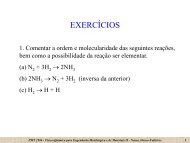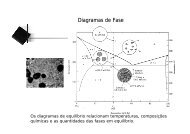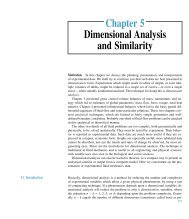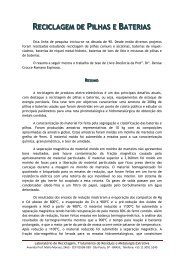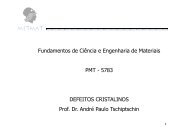The Use of a Vickers Indenter in Depth Sensing Indentation for ...
The Use of a Vickers Indenter in Depth Sensing Indentation for ...
The Use of a Vickers Indenter in Depth Sensing Indentation for ...
You also want an ePaper? Increase the reach of your titles
YUMPU automatically turns print PDFs into web optimized ePapers that Google loves.
Vol. 7, No. 3, 2004 <strong>The</strong> <strong>Use</strong> <strong>of</strong> a <strong>Vickers</strong> <strong>Indenter</strong> <strong>in</strong> <strong>Depth</strong> Sens<strong>in</strong>g <strong>Indentation</strong> 485<br />
<strong>for</strong> Measur<strong>in</strong>g Elastic Modulus and <strong>Vickers</strong> Hardness<br />
where b corresponds to a correction factor related to the lack <strong>of</strong><br />
symmetry <strong>of</strong> the <strong>in</strong>denter, which is equal to 1.0124 <strong>for</strong> <strong>Vickers</strong><br />
<strong>in</strong>denters, and A c<br />
is the projected contact area.<br />
Figures 1 to 3 show the ma<strong>in</strong> parameters used <strong>in</strong><br />
analyz<strong>in</strong>g <strong>in</strong>dentation data.<br />
In Figs 1 and 2, h max<br />
corresponds to the maximum depth,<br />
a to the half-diagonal projected on the surface, h f<br />
to the<br />
residual depth, h c<br />
to the contact depth, and h s<br />
to the deflection<br />
depth. In Fig. 3, S corresponds to the unload<strong>in</strong>g stiffness<br />
<strong>for</strong> h = h max<br />
.<br />
As the unload<strong>in</strong>g from h max<br />
to h f<br />
is elastic, one <strong>of</strong> the<br />
Sneddon’s solutions 8 , <strong>for</strong> a conical punch (Figs. 1 and 2),<br />
shows that the deflection <strong>of</strong> the surface at the contact is:<br />
<strong>The</strong>re<strong>for</strong>e:<br />
(10)<br />
(11)<br />
Consider<strong>in</strong>g that usually the <strong>in</strong>denters are not conical,<br />
but square or triangular base pyramids (<strong>Vickers</strong> or Berkovich<br />
<strong>in</strong>denters) it must take <strong>in</strong>to account that <strong>for</strong> any revolution<br />
paraboloyd (<strong>in</strong>clud<strong>in</strong>g <strong>Vickers</strong> <strong>in</strong>denters), ε is about 0.75 19 .<br />
As one can see <strong>in</strong> Fig. 4a, the contact area, A c<br />
, can be<br />
expressed as a function <strong>of</strong> the diagonal d 21 :<br />
Another Sneddon’s solution shows that, <strong>for</strong> h = h max<br />
, the<br />
load is related to the elastic depth:<br />
(7)<br />
(12)<br />
Substitut<strong>in</strong>g this expression <strong>in</strong> Eq. 6, one obta<strong>in</strong>s the<br />
diagonal as a function <strong>of</strong> the <strong>in</strong>dentation parameters:<br />
Substitut<strong>in</strong>g (7) <strong>in</strong> (8) and not<strong>in</strong>g that the contact area<br />
<strong>of</strong> <strong>in</strong>terest is that at peak load, P = P max<br />
, it follows:<br />
(8)<br />
or (9)<br />
To determ<strong>in</strong>e the contact depth from experimental data,<br />
one can note that <strong>in</strong> Fig. 1:<br />
(13)<br />
Eventually, the <strong>Vickers</strong> hardness numbers can be determ<strong>in</strong>ed<br />
by the average diagonal, d, estimated from such parameters:<br />
(14)<br />
Figure 1. Pr<strong>of</strong>ile <strong>of</strong> the surface be<strong>for</strong>e and after <strong>in</strong>dentation.<br />
Figure 2. Ma<strong>in</strong> parameters used <strong>in</strong> analyz<strong>in</strong>g unload<strong>in</strong>g vs. <strong>in</strong>denter<br />
depth curves.<br />
Figure 3. Schematic representation <strong>of</strong> load-displacement data <strong>for</strong><br />
a depth sens<strong>in</strong>g <strong>in</strong>dentation experiment.





